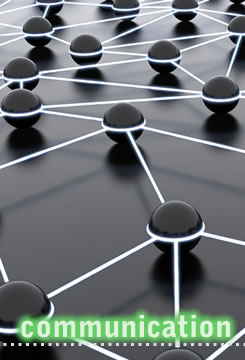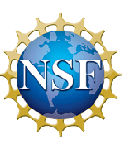-
Communication Thrust
-
 The communication thrust is a direct extension of Shannon's point-to-point communication to a networked environment. The Center focuses on integrating elements of delay in information theory, information in networks, new measures in information, and the so called non-asymptotic limits. We elaborate on these goals below:
The communication thrust is a direct extension of Shannon's point-to-point communication to a networked environment. The Center focuses on integrating elements of delay in information theory, information in networks, new measures in information, and the so called non-asymptotic limits. We elaborate on these goals below:Delay in Information Theory : Quantifying the performance limits for coding systems complying with various restrictions on their operations, including causality, delay constrains, memory and complexity constraints, and the availability of feedback and of side information. We aim to understand the performance attainable under various combinations of such restrictions. Do the fundamental limits here give rise to measures of uncertainty and dependence other than entropy and mutual information? Among others, the Center aims to develop a better understanding of:
- Quantifying the temporal value of information
- Information theory for finite block lengths
- Tradeoffs between delay, distortion, and reliability in feedback systems.
Such understanding will fundamentally influence the design of practical systems.
Information in networks : Studies at the Center are aimed at understanding communication between agents, subject to a variety of different assumptions on communication. Agents may also interact with the physical world. The configuration may be dynamic: agents may move, and their communication capabilities and external interactions may change over time. In such scenarios, one needs to understand communication, computation, and coordination among the agents. How does information flow through a distributed network? What is the type and amount of information necessary to solve distributed tasks in dynamic networks? These investigations will lead to new classes of problems relating to scaling laws and the microscopic-macroscopic transition.
Information and computation : The distributed and increasing interconnected nature of information leads to new challenges in the study of information networks and interactive computation. Most information today does not lie in any single location in the network, is often replicated and sometimes inconsistent. And the spatial location of information is itself important to establishing its context and utility. These novel aspects lead to a host of new problems.
- Quantifying fundamental limits of in-network computation, and the computing capacity of networks for different functions
- Complexity of distributed computation in wireless and wired networks
- Information theoretic study of aggregation for scalable query processing in distributed databases
- Fundamental limits of interactive communication
- Applications and implications (e.g., for collaborative computation).
New measures and notions of Information : In order to solve aforementioned problems, the Center aims to develop new measures of information that quantify among others:
- Soft-information (beliefs) in rate distortion theory
- Semantics in information: framework, probabilistic modeling.
- Modern communication networks, such as the Internet and its overlaid networks (e.g. social networks) pose several new and important kinds of questions relating to what kind of "information" is carried over them. Examples include notions of structural information such as the information carried in the routes used by the flows (which it is often of interest to hide) and the information carried in patterns of behavior (which it is often of interest to extract, e.g. for targeted advertising).
Interface with Life Sciences Thrust : The Center engenders a tight collaboration between the life sciences and communication thrusts. On the communication side, the Center addresses the follow problems relevant to Life Sciences:
- Furthering our information theoretic understanding of deletion, substitution, and insertion channels.
- Information theoretic models for evolution
- Models for stimuli
- Communication models for intra-neuron signaling
- Models to predict the behavior of various systems, ranging from intra-cellular, to tissues, individuals, colonies, and ecosystems.
To know more, please contact
E-mail : soi-stc@purdue.edu
Phone : (765) 494-2908


